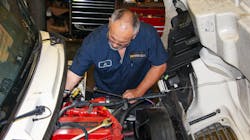Repair and maintenance make up 9% of a fleet’s total average marginal cost of operation, according to the American Transportation Research Board’s An Analysis of the Operational Costs of Trucking: 2020 Update.
However, regardless of the cost, maintenance is critical to the efficient operation of tractors and trailers. Vehicle and component manufacturers set maintenance schedules based on what they think is best, and fleets modify those schedules based on their own operating conditions.
Most fleets have an in-depth inspection as part of their regular preventive maintenance (PM) service that gives them a chance to put eyeballs on various areas of the truck. These inspections combined with regularly scheduled maintenance service help prevent roadside breakdowns and allow fleet maintenance managers to spot problems that could result in CSA violations, which can lead to fines or even vehicles being taken out of service.
Scheduling PM service is one step in the PM process; the other is tracking PM compliance. Fleets need a system that allows them to see when a scheduled PM has been missed so they can make sure to pull that truck into their shop or get it scheduled at an outside service provider to make sure the PM is completed.
PM compliance always has been important, but it has taken on greater importance recently. We are all aware of the fact that truck manufacturers’ build slots are booked for the remainder of this year and well into next year. In fact, several truck makers have closed orders for 2022—although they are likely to open them once they gain a better understanding of the chip and raw materials shortages affecting the ability to manufacture equipment. What this means is that many fleets will have to hold on to their existing assets for longer than they had originally planned.
We all know that older assets need extra attention and for those assets, the fleet is extending beyond their normal operating cycle, ensuring maintenance is scheduled is even more critical than it is for newer vehicles.
Make sure you have a system in place that not only tells you when PMs are due, but whether a truck came in for its scheduled maintenance service. In today’s market, missing even one scheduled PM appointment can mean a truck broken down on the side of the road along with an unhappy driver and customer.
Gino Fontana, CTP, is COO and EVP at Transervice Logistics Inc. Prior to this recent promotion, he was VP of operations at Berkeley Division and Puerto Rico. His operational expertise emphasizes cost savings, process efficiency and improvement, superior quality, and people management skills. He has more than 35 years of experience in the transportation and logistics industry with both operational and sales experience.
About the Author
Gino Fontana
Chief operating officer and executive vice president at Transervice Logistics Inc.
Gino Fontana, CTP, is COO and EVP at Transervice Logistics Inc. Prior to this recent promotion, he was VP of operations at Berkeley Division and Puerto Rico. His operational expertise emphasizes cost savings, process efficiency and improvement, superior quality, and people management skills. He has more than 35 years of experience in the transportation and logistics industry with both operational and sales experience.
